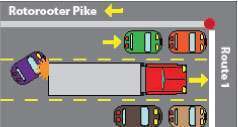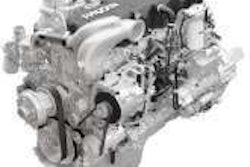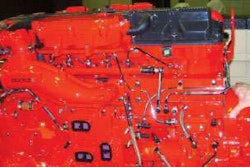Improvements were seen in both drivers and vehicles regarding the number of out-of-service (OOS) violations and citations issued per roadside commercial vehicle safety inspection during the annual Operation Safe Driver education and enforcement blitz, the Commercial Vehicle Safety Alliance announced. However, the results also showed an increase in moving traffic warnings and citations for all drivers.
 This year’s Operation Safe Driver event included 5,231 law enforcement personnel at 1,177 locations across the United States and Canada.
This year’s Operation Safe Driver event included 5,231 law enforcement personnel at 1,177 locations across the United States and Canada.Data collected during the third annual campaign, held Oct. 18-24, reveals that while some aspects of driver and vehicle violations were down from 2008 with respect to safety inspections, there was an increase in 2009 in traffic enforcement warnings and citations issued for truck, bus and passenger vehicle violations. This year’s event included 5,231 law enforcement personnel at 1,177 locations across the United States and Canada.
The campaign, created in 2007 by CVSA in partnership with the Federal Motor Carrier Safety Administration, addresses the problem of improving the behavior of all drivers operating in an unsafe manner — either in or around commercial vehicles — and to take aggressive enforcement action on those exhibiting high-risk behaviors.
“The Operation Safe Driver Campaign reminds us that while we have seen steady progress in the areas of commercial vehicle and highway safety, there is still more we must do to promote safe driving practices,” says FMCSA Administrator Anne S. Ferro.
Highlights of the 2009 Operation Safe Driver enforcement results include:
• 30,294 CMV roadside inspections, of which 5.4 percent resulted in the driver being placed OOS and 26.1 percent of the Level I Inspections resulted in the vehicle(s) being placed OOS. In 2008, there were 32,708 inspections conducted and a driver OOS rate of 5.3 percent;
• For drivers: 0.44 violations per roadside inspection (0.43 in 2008); 0.08 OOS violations per roadside inspection (0.14 in 2008) and 0.04 citations per roadside inspection (0.08 in 2008);
• For vehicles: 1.12 violations per roadside inspection (0.74 in 2008); 0.19 OOS violations per roadside inspection (0.38 in 2008) and 0.05 citations per roadside inspection (0.11 in 2008); and
• Of 20,198 CMV driver traffic enforcement contacts, 6,887 warnings were issued (0.34 per contact) and 8,067 citations were issued (0.40 per contact). In 2008, there were 16,784 contacts, which resulted in 3,247 warnings (0.19 per contact) and 6,143 citations (0.37 per contact).
FocusDriven to target distracted driving
U.S. Transportation Secretary Ray LaHood and National Safety Council President Janet Froetscher announced the creation of FocusDriven, the first national nonprofit organization devoted specifically to raising awareness about the dangers of distracted driving. The group will be led by Jennifer Smith, who has been an outspoken advocate against distracted driving since her mother was killed by someone talking on his cell phone while driving in 2008.
FocusDriven, modeled after Mothers Against Drunk Driving (MADD), is a direct outgrowth of the September 2009 national Distracted Driving Summit in Washington, D.C.
Since the two-day meeting that brought together affected families, law enforcement, researchers, public officials and others, family members of distracted driving victims have worked to establish an advocacy organization with support from DOT and NSC, a nonprofit organization that uses leadership, research, education and advocacy to prevent injuries and save lives. FocusDriven’s new website, www.focusdriven.org, hosts information on distracted driving, help for victims and family members, and ways to get involved.
Putting an end to distracted driving is a top priority for LaHood and DOT. The department recently launched a federal website, www.distraction.gov, with comprehensive information on distracted driving, as well as a national PSA featuring LaHood to raise awareness about this dangerous driving behavior. “Just as groups like MADD changed attitudes about drunk driving, I believe
FocusDriven can help raise awareness and change the way people think about distracted driving,” he says. “Together, I hope we can put an end to this dangerous practice.”
The Minnesota Trucking Association in January announced its own yearlong effort to provide information and training to its members and their drivers to improve road safety. The “Keep Both Hands on the Wheel” campaign will focus on reducing distracted driving by asking truckers, their employers, contractors and the public to follow safe driving habits.
In brief
The truck-involved fatality rate in 2008 declined 12.3 percent to 1.86 per 100 million miles from 2.12 per 100 million miles in 2007, according to truck Vehicle Miles Traveled (VMT) figures released last month by the Federal Highway Administration. This decline marks the largest year-to-year drop ever and the fifth consecutive year the fatality rate has improved. For more data, go to www-nrd.nhtsa.dot.gov/Pubs/811172.pdf
ACS Expedited Solutions and Sleep Pointe now offer a sleep apnea safety compliance reporting system using the TripPak Truck Stop Scanning network. Drivers who use Sleep Pointe APAP machines now have the ability to send data from their machine through the TripPak Truck Stop Scanning network to a Sleep Pointe compliance portal managed by ACS.
U.S. Department of Transportation released its Motorcoach Safety Action Plan that proposes to initiate a rulemaking to prohibit texting and limit the use of cellular telephones by motorcoach drivers. It also discusses enhanced oversight of unsafe carriers and requiring electronic onboard recording devices on all motorcoaches. To view the action plan, go to http://www.nhtsa.gov/staticfiles/DOT/NHTSA/reports/H5811177.pdf.
Sindall Transport took First Place in the General Commodities Truckload/Line-Haul/Between 0-10 Million Miles category of the annual American Trucking Associations’ 2009 Truck Safety Contest for achieving a vehicle accident ratio of zero.
FleetMentor, the online fleet management adviser by J.J. Keller & Associates, launched a CSA 2010 Resource Center (www.fleetmentor.com/CSA2010/Overview1.aspx) to assist in preparing for FMCSA’s Comprehensive Safety Analysis initiative.
Preventable or not:
Yellow not Doe’s favorite color
Thinking about the nifty bass boat he’d bought last week (from fellow trucker Teddy Trotley) put John Doe in a good mood. He approached Unit 402 on the ready line with his logbook, an economy-size bag of Spicy Ranch Doritos, his copy of the official Bass Lure Handbook, a giant Thermos of coffee and other life-supporting essentials. It was a pleasant, cool February morning.
 Seeing the yellow signal light, John Doe was coming to a stop at the intersection when an impatient compact car driver, unaware of the changing signal, tried to pass but struck the rear of the slowing big rig’s trailer. Was this a preventable accident?
Seeing the yellow signal light, John Doe was coming to a stop at the intersection when an impatient compact car driver, unaware of the changing signal, tried to pass but struck the rear of the slowing big rig’s trailer. Was this a preventable accident?An hour later, Doe’s tractor-trailer was occupying the center, eastbound lane of Rotorooter Pike, at the legal limit of 55 mph, in moderate traffic. When the traffic signal at the intersection with Route One suddenly turned yellow, Doe slowly started to brake, setting the stage for disaster. Immediately behind Doe was a purple AMC Hornet impatiently piloted by Margie Mudswange, who was waiting for a chance to change lanes and get away from the nasty ole truck.
Mudswange did not notice Doe’s brake lights, and she couldn’t see the traffic signal, which now was cherry red. Squinting through inch-thick glasses, Mudswange had just checked her mirrors and was preparing to whiz past Doe when … EEEK!!! Too late, Mudswange saw that the big rig was slowing down! So she attempted, but failed, to squeak past the left corner of Doe’s trailer … BLAMMOWHAMMO!!! Its radiator smooshed, poor Mudswange’s Hornet no longer was capable of buzzing down the highway.
Because the company safety director questioned Doe’s inability to avoid being struck in the rear by the Hornet, the National Safety Council’s (NSC) Accident Review Committee was asked to settle the issue. NSC quickly ruled in Doe’s favor, noting that he had no reason to anticipate being attacked by the myopic Mudswange.














